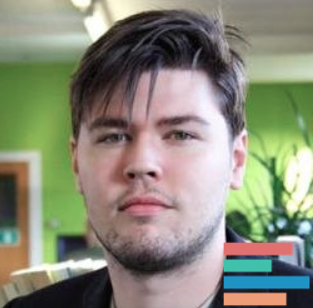 Whether you’re pre-launch, post-Product / Market Fit (P/MF), or an expansion stage SaaS vendor, Growth Hacking – the methods, tactics, and especially the mindset behind it – can be leveraged by companies at all stages to accelerate growth.
Whether you’re pre-launch, post-Product / Market Fit (P/MF), or an expansion stage SaaS vendor, Growth Hacking – the methods, tactics, and especially the mindset behind it – can be leveraged by companies at all stages to accelerate growth.
Of course, the stage of your company dictate what growth you’re trying to hack achieve, the success metrics for those initiatives, and the methods or tactics you’ll use.
And while the Growth Hacking tactics a pre-launch startup would use – to build interest, get press, or generate market-validating revenue, for example – may differ from the tactics an expansion-stage SaaS firm focused on increasing Dollar Revenue Retention (DRR) would use, it is very helpful to learn about methods that work at all stages even if it doesn’t directly correlate to your current situation.
Which brings me to a conversation I had with Liam Gooding of Trak.io a couple of months back about Growth Hacking at very early-stage startups.
I’ll let Liam go into the details, but essentially, while Trak.io was in invite-only beta with a lengthy wait to get in, as a way to offset infrastructure costs and – frankly – to see if people were willing to pay for early access to Trak.io, Liam and his team implemented a “jump the queue” one-time fee.
And, well, it worked… and Liam was kind enough to share exactly what they did, the specific results, and the thinking behind this early-stage Growth Hack.
What Liam and his team did with Trak.io is applicable to SaaS companies in the earliest stages, of course, but I think the psychology and thinking that they used – and what goes into making Growth Hacking successful in general – apply across the board.
Don’t let the fact that Trak.io was in beta when they did this – and you’re not – keep you from paying attention to what he has to say… if you do, you’re only hurting yourself!
I’ll add a couple of thoughts to what Liam talks about – as well as share an awesome resource he is putting together for you – in the Afterword.
Okay, I’ll turn it over to Liam now…
Growth Hacking: How We Achieved 11% Conversion Rate on Upfront Payments
Within 2 weeks of onboarding people into the private Beta at Trak.io, we’d overloaded the servers and needed to slow down and limit how we brought users in – we were unfunded and a hosting bill approaching $1,000 /mo seemed quite daunting.
So we decided to try something pretty radical – we starting asking people to pay to get into our Beta. Before they’d used or even seen the working product.
They’d shown interest via a landing page, read our value proposition and listened to what problems we were trying to solve for them. And that’s it. We asked for $29, as a one time payment.
When presented with the deal, 11% of people paid with their credit cards. Here’s how we did it, and all of the numbers.
1. People Want It Now!
Because we decided to make people wait a while between signing up and actually receiving their invite code, we lost some people. Actually, “some” is the wrong word.
We lost around 50% of our waiting list. And that was only for a few weeks wait.
That’s huge.
Our efforts on acquisition were literally halved because we were asking people to wait a few weeks. I was personally reaching out to as many people as possible to start conversations and to give people their invites. We also used an automated email sequence to keep the signups engaged with useful content and offer them multiple opportunities to use their promo code.
I emailed users who never bothered to use their access codes, and the overwhelming responses were “I’d forgotten what it was, I went and signed up for something else, I’d lost interest“
I knew we needed to give it to people now. But we were full. I needed some kind of quality filter.
So our $29 paid option became a ‘Priority Access’ program. Everyone eventually gets access for free, but those who are seriously looking for a solution NOW to fix a business problem, they can pay and get it now.
All of the marketing copy around the paid option focusses on language like now, time poor, waiting… I stress that not paying means they’ll be waiting for a few weeks. I also give an explanation as to why we have to make people wait weeks.
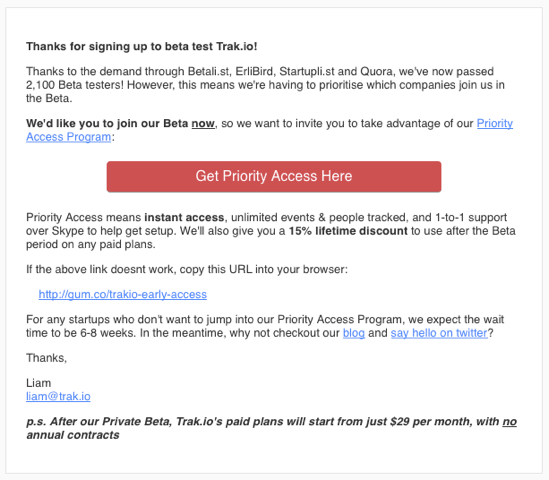
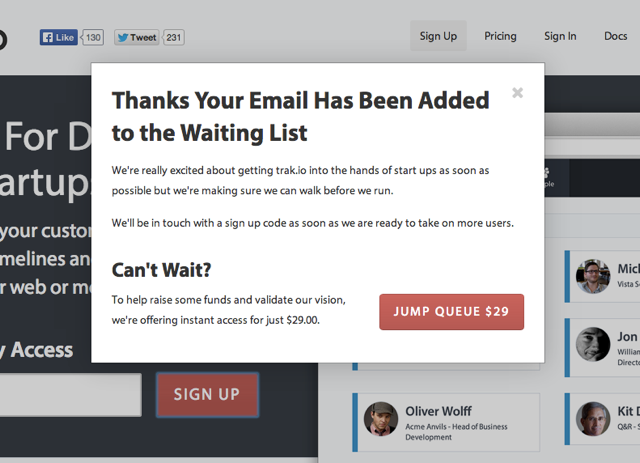
2. People Want A Bargain For Being Early Adopters
We weren’t really trying to offset the cost of servers with the payments from the Priority Access program. Instead it was all about validating our beta testers with a quality filter.
But we wanted to make sure they got a great deal for their money. Not just instant access. Honestly, I was nervous I was going to turn away everyone.
So we sweetened the deal, offering a 15% lifetime discount on whatever our paid plans happen to be. We also promised that they’d receive at least 2 months of usage of the product for free within their beta access. So worst case scenario, $29 bought 2 months of subscription.
We also promised that their usage would be completely unlimited. No matter how big they are. Considering some of our beta testers send enough data to need a $499 /mo plan with KISSmetrics, that was quite a bargain.
Trak.io is lucky to be in a market with a few comparable companies. That makes the perception of a bargain is pretty easy to communicate to customers, at least on the surface of commodity pricing.
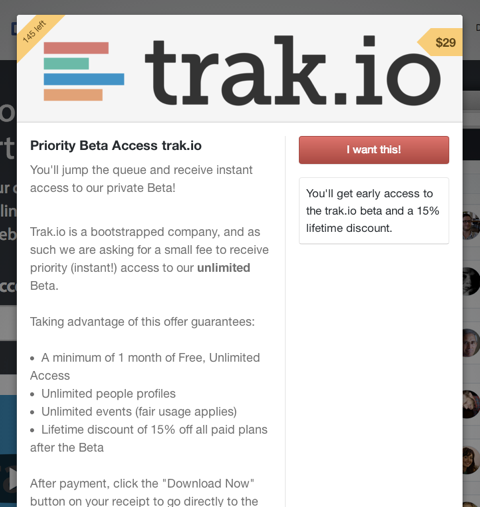
3. People Want Guarantees
As a brand new company, we needed to make sure we did our best to promote trust and confidence. So as well as the usual registered company number and address, we offered a no quibble refund policy, without any limits.
This was important as until a tester has integrated our API and sent some data, they might not know if the product will actually fit their needs.
Out of 105 needs, we’ve made 3 refunds. All 3 were people who were looking for a particular feature that was in our marketing messages but we’d actually not deployed it yet. We refunded all 3 and still let them stay in the Beta because we hope they’ll come back once the feature is live and give us feedback!
In the grand scheme, refunding a beta tester isn’t a huge issue. They’ve already validated our marketing message with their payment, and provided us strong product signals by giving us the reason for requesting a refund, so if anything the refunds are more valuable!
4. People Want Personal Support
On our sales page, people were offered a personal email from the CEO and hand-holding technical support in getting setup. Almost every $29 signup took advantage of this.
Which is amazing.
I want to have conversations with our beta users. I need to have constant dialogues. Writing a bit of JS and debugging their landing pages (95% of the time they’ve forgot to include jQuery!) is a tiny price to pay to be able to get to know our users.
Scaleable? Probably not.
But promising people that for only $29, they’ll have a few hours of hands on support with senior developers makes them feel confident and comfortable. We’re a developer API product and can be quite daunting (something we’re constantly working on improving).
Knowing that they have the two cofounders Skype names and can call at any time is a big comfort.
5. People Want Sexy
Users were asked to pay for software after only seeing our landing page and the Gumroad offer. We hadn’t yet let them have a play around the application at all. And the development overhead of a robust Demo staging server with dummy data didn’t make sense yet.
We knew that user interface was going to be one of our differentiators among competitors, and so we knew we could use this on our landing page. So we had lots of screenshots, and made these screenshots into a video (which took around 30 minutes to make – it’s embarrassing to watch now!)
Would we have made these sales without a beautifully designed landing page or beautifully design interface screenshots? No, I don’t think so. I don’t think we’d have made one.
In a world of Lean Startup, design is the cheapest way to demonstrate prototypes, and I believe it has far higher ROI’s on a product. A great interface design makes software accessible.
In Lean Analytics, Alistair Croll and Ben Yoskovitz advise that good metrics should be Accessible, so we knew that our product needed to be sexy and appealing. Something people wanted to grab and touch. And pay for.
The Numbers and Total Revenue
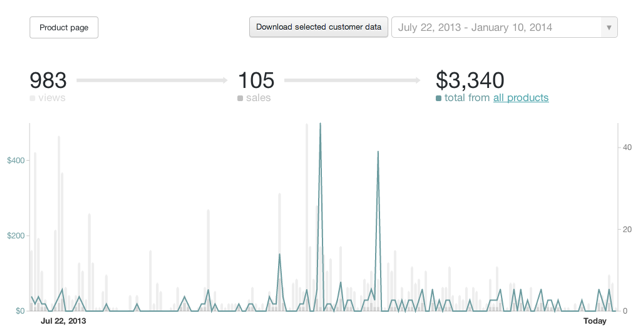
Total views: 983
Total Sales: 105
Conversion rate: 11%
Total Revenue: $3,340
Note: The above revenue includes 2 x $499 Launch Partner deals we sold, 12 months of Trak.io for $499 paid upfront, both bought by people who had bought our $29 offer first.
Disclaimer: Why Is This A ‘Growth Hack’?
Before anyone gets a hernia arguing that I’m using a buzzword to bring some SEO-juice to this post, I just wanted to explain my reasoning.
I could find no example of any B2B SaaS product offering a paid option to skip a Beta waiting list queue. Tweets and Likes, yes. But not paid. So I think this was an innovative and risky experiment.
This also allowed us to grow the Beta a lot faster and gain qualitative feedback much faster. Our paid access Beta testers were more responsive to all my emails (90%+ response rate v.s 25%) and are already sending email referrals (9 email introductions from paid access testers, 0 from free access testers).
We implemented this paid option in under 1 hour. We dropped in Gumroad’s embedding API. Implementing our full Stripe recurring billing system is around 2 weeks of development time for my cofounder Matt.
This took 1 hour, and I could do most of the work (setting up the Gumroad product) with a simple embed code on our landing page. This was very low cost to implement.
And remember what Lincoln says:
While you’re out trying to define and defend #growthhacking your competition just stole your market share
— Lincoln Murphy (@lincolnmurphy) November 25, 2013
Liam Gooding is CEO and Co-Founder of Trak.io … learn more about them on AngelList
Afterword by Lincoln
Lincoln here again…
Just a few things to add.
While there are many takeaways here – including doing the right thing when it comes to refunds – one thing you might have missed is how Liam knew where Trak.io sat adjacent to other products in their customer’s world, in this case understanding their customer’s use of – and commercial relationship with – KISSMetrics.
By clearing understanding that the level of activity they were seeing would require a customer to pay KISSMetrics at least $499/mo – and knowing where Trak.io sits compared to KISSMetrics in their world – they can see that prospects are already spending money in this space and even get some idea of the price sensitivity of their prospects.
That said, whether it’s beta or not, invite systems, queues, and requiring people to wait are a fun mix of tricky and potentially lucrative.
Take Stealth Seminar – an automated webinar service – for example… they’re all about scarcity, making you wait for access, but keeping you engaged, and then opening up access – at a premium – at some pre-determined point in the near future.
The problem is that when it’s false scarcity – i.e. completely made-up to provide the illusion that resources or access are limited – then that’s potentially not cool. You have to tread lightly here.
But in the case of Trak.io, this was’t false scarcity… this was a way to get people into their beta who were most likely to use the product and provide valuable feedback.
Instead of vetting testers, sorting and sifting through applications to find those that were most likely to be valuable testers… they let them self-identify as serious… with their credit card!
People who pay you – anything – always give different and generally more helpful feedback than those getting something for free, which is why I say get to market and start charging money for your product as quickly as possible.
And honestly, that’s why I’m actually not a big fan of “beta” periods in the traditional SaaS sense… I think it tends to send the wrong message (i.e. not production ready). So just be careful out there.



